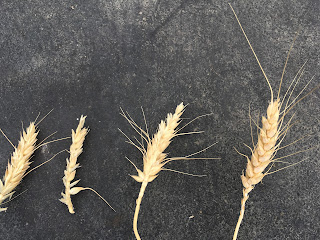This a reconstruct of a 2019 post that I lost in an attempt to update after I recently noticed that the videos would not run. This is four years out of sync with the post, (below), titled " STRIPPER HEADER -- YES/NO", August 6, 2023.
Because of CANOLA we upgraded our combine from a 1985 Gleaner N7 to a 2013 Gleaner S77. The N series did not have enough room in the threshing area to allow canola stems to pass through blocking the area leading to the accelerator rolls. The S series has an enormous amount of room allowing free flow. S77 came with a 30' AGCO 8200 flex header with a Crary Air Reel. The auger has exceptionally deep flighting and retractable fingers the full length of the auger. It is very aggressive in moving bulky crop material to the feeder house of the combine.When mounting the Shelbourne 2012 CVS32 on the N7, we upgraded the feeder house mounting that included tilt control. This allowed us to direct mount the header on a 28 year newer combine. To this point in time we have been harvesting canola and mustard with the CVS32 and putting up with the blockage issue because the standard head on the N7 did not move bulky material well. Since we now have the 8200 with the ability to harvest bulky crop material we decided to compare the two headers for harvesting canola. We liked the CVS32, but had some concern about rotor finger wear from processing the branch material associated with canola/mustard.
The 20 second video above is of the AGCO 8200. The 38 second video below is of the CVS32.
The results of our comparison are: The measured AGCO 8200 loss was 60% of the CVS32. There are caveats to this however. First of all, I was surprised how little seed was in the catch pan with the AGCO even though the reel was deep in the crop as shown in the video. On the other hand the AGCO was missing a significant number of pods on low branches that didn't show in the pan. These pods were being pushed down under the cutter bar. Adjustments probably could have been made to catch those pods. OK!, I'll accept the idea that the AGCO header has less header loss than the CVS header in canola. What other comparisons can we make? The CVS does not strip green material and put it through the processor like a sickle head. This includes green crop pods/heads, and weedy material. There was more growling of the processor with the AGCO. Obviously more material was being processed. --cleaner sample with the CVS because of less processing of green material. --faster cutting with the CVS. The CVS will fly through canola compared to the AGCO. Speed is limited only by shatter from the pods impacting the nose of the hood. Less material laying on the ground with the CVS. Although most of the branching is processed, the stalks along with some branches and weed residue are left standing. This leaves a better field condition for low disturbance single or double disc drills to seed the following crop. --less tire wear/damage with the CVS. The stalks are left longer, hence tires/tracks bend the stalk over instead of spearing. --better moisture retention. Long stalks, although not nearly as dense as wheat stubble, does a good job of trapping snow and leaving it in place on the field.
This year we experienced some rain while harvesting winter wheat. Even though the amounts were light, the humidity was high and delayed harvest. With the CVS we were able to start several hours earlier than those with sickle heads. This condition left the standing stubble with a different look, more head material left on the stalk, but I didn't find one kernel left in a head. The following pic's are examples.
These heads were picked from the ground. All the kernels were removed, although they look pretty much intact.
We love the Shelbourne heads and use it almost exclusively; however, there are conditions where it won't work as well as a flex head with sickle cut. Being rigid over 32' is definitely problematic with short crops in our hilly topography. I drove the combine for the first time in years and found it difficult to keep the header leveled with the crop. I'm surprised that Kye hasn't complained louder about the need for auto header tilt and height control. It's critical for the crop hit the nose of the hood at the proper height, and manual tilt adds operator stress to maintain that optimum contact. Header height is critical for hood height. We will add the auto control for these two functions next harvest. Auto header control for the CVS is significantly more expensive than for a regular sickle header. We were told that more ticklers and faster data processing was needed to avoid ground strikes at speeds operators drive the CVS.




No comments:
Post a Comment